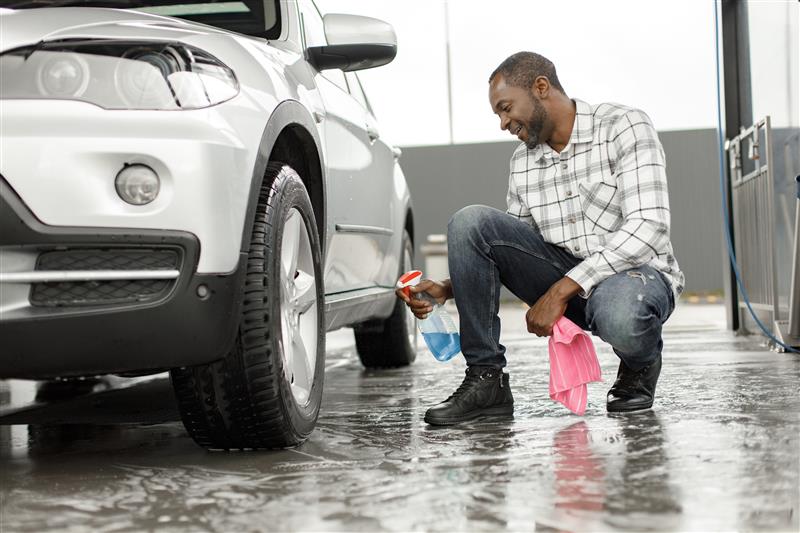Clear vision ahead with our holiday markdowns on Invisible Glass Ceramic Silicone Wiper Blades. Prices as marked.
There’s something incredibly satisfying about seeing a car gleam like it just rolled off the showroom floor. Car detailing goes beyond a basic wash. It involves cleaning, restoring, and protecting every part of your vehicle, inside and out. For beginners, the process can seem overwhelming at first. But once you understand the core steps, it becomes a satisfying routine that helps your car look better and last longer.
If you're ready to dive into car detailing, these beginner tips will get you on the right path.
Start with the Basics: What Car Detailing Really Means
Washing your car removes surface dirt, but detailing takes it further. It includes deep cleaning, restoring worn surfaces, and protecting both the interior and exterior. That might mean polishing paint, conditioning leather, or applying a wax or ceramic coating to guard against weather and wear. A well-detailed car not only looks better but also holds its value and creates a more enjoyable driving experience.
Gather the Right Tools Before You Start
Using the wrong products can damage your car’s surfaces, so it is crucial to begin with the right supplies. A solid starter kit should include:
● pH-balanced car shampoo
● Microfiber wash mitt
● Several microfiber towels
● Soft bristle wheel brush
● Quality wax or paint sealant
● Interior cleaner that is safe for surfaces like dashboards and seats
● Shop vacuum or car vacuum for interior cleanup
Having the right tools ready makes the job easier and protects your vehicle from avoidable wear.
How to Use the Two-Bucket Wash Method for Safer Car Detailing
When it is time to start washing, technique matters just as much as your choice of products. The two-bucket method is a simple but effective way to protect your paint from scratches.
Use one bucket for soapy water and another for rinsing your wash mitt between panels. Rinsing in a separate bucket prevents dirt and grit from contaminating your clean water, which reduces the risk of swirl marks caused by debris rubbing against the paint.
Another important tip: wash from top to bottom. The lower parts of your car collect the most dirt, so working from the roof downward helps prevent dragging grime over already clean surfaces.
How to Clean Wheels and Tires During Car Detailing
Wheels collect more brake dust and road grime than any other part of the car. Clean them first, before washing the rest of the vehicle, to avoid spreading debris. Use a wheel-specific cleaner to break down buildup, and a dedicated brush to reach around lug nuts and between spokes. Taking the time to clean your wheels thoroughly makes a noticeable difference in your car’s overall appearance.
How to Dry Your Car Without Water Spots: Detailing Tips
Letting your car air dry may seem harmless, but it often leaves behind water spots. Use a large microfiber drying towel and gently pat the surface dry. Avoid dragging the towel, since even soft fabric can cause micro-scratches if any debris remains. A careful drying process helps preserve your paint and keeps the finish looking sharp and vibrant.
Use a Clay Bar for a Smooth, Contaminant-Free Finish
Even after a thorough wash, tiny contaminants can remain on your paint. If the surface feels rough to the touch, a clay bar can help smooth it out. This tool safely removes embedded debris that soap and water leave behind.
Spray a lubricating solution on the paint and gently glide the clay bar across the surface. It will pull out particles without scratching. Detailers always recommend claying before applying wax, sealant, or ceramic coating, since a smooth, clean surface helps these products bond more effectively.
Want a deeper walkthrough? See our complete guide here.
Protect the Paint with Wax, Sealant, or Ceramic Coating
Once your paint is clean and smooth, protection is the next step. Wax has long been a favorite for its deep shine and short-term defense, typically lasting two to three months. Paint sealants offer longer-lasting protection and are often easier to apply. Ceramic sprays are a newer option with strong durability and hydrophobic properties, making them ideal for daily drivers, even for beginners.
Regardless of the product you choose, applying a protective layer is essential. It locks in your hard work and shields your paint from the sun, water, and environmental damage.
Detail the Interior for a Complete Finish
A well-detailed car should look just as good on the inside as it does on the outside. Begin by thoroughly vacuuming the seats, mats, and carpets. Use a soft detailing brush to clean air vents, seams, and cup holders. Wipe hard surfaces, such as dashboards and door panels, with a residue-free interior cleaner to restore their original look without leaving behind shine or grease.
If your vehicle has leather seats, condition them after cleaning to maintain their appearance. Leather conditioners help prevent drying and cracking by restoring essential oils, keeping the material soft and comfortable.
Final Tips for a Flawless Detail
Use these final tips to finish strong and avoid common mistakes after completing the main steps:
-
Leave the Glass for Last
It may be tempting to clean the windows as you go, but it is best to wait until the end of the detailing process. By then, any dust or product residue will have settled. Use an ammonia-free glass cleaner and a clean microfiber towel, wiping in straight lines to avoid streaks. Do not forget to roll the windows down slightly so you can clean the top edges.
-
Work in the Shade
Direct sunlight dries soaps and cleaners too quickly, leaving behind spots and streaks. Try to detail in a shaded area or work during cooler parts of the day, such as early morning or late afternoon. Your products will perform better, and the process will be more comfortable.
-
Be Patient and Take Your Time
Rushing through a detail often results in missed areas, scratches, or uneven finishes. Think of detailing as time spent caring for your vehicle, not as a task to check off. With practice, your technique will improve, and the process will become faster and more efficient.
Finish Strong: What Makes a Detail Truly Complete
Car detailing keeps your vehicle clean, protects its finish, and helps it retain its value over time. It also turns routine maintenance into something more personal and satisfying. With the right tools and products, a straightforward process, and a little patience, even beginners can get professional-looking results.
Take the time, do it right, and enjoy the reward of driving a car that looks and feels its best!

